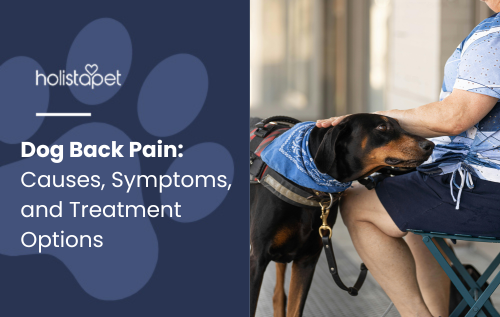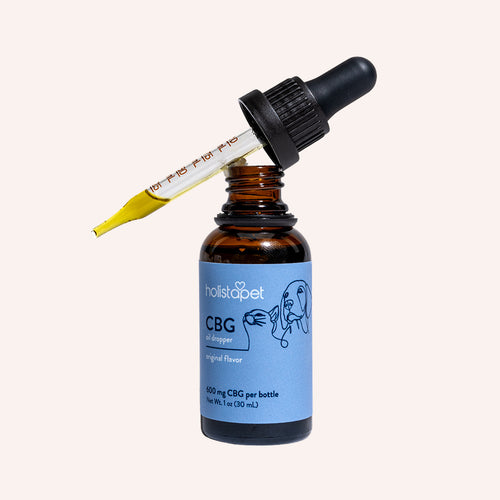Believe it or not, back pain in dogs sends more pups to the vet than you'd think. Just like us, dogs can twist, sprain, or strain something by simply making the wrong move, and don't forget the effects of aging on the back. Whether it's from a soft tissue injury, a sudden jump off the couch, or something more serious, dog back pain can affect dogs of all shapes and sizes.
Back pain in dogs often shows up as stiffness, whining, or odd posture. Curious about what causes it, how to spot the signs, and what you can do to help your pup feel better? Keep reading—we've got your back!
How to Recognize Back Pain in Your Dog

If your dog moves stiffly, arches their back, or suddenly slows down on walks, they might be dealing with dog back pain. Keep an eye out for changes in your dog's posture, especially if they avoid stairs or flinch when touched. Back pain in dogs can sneak up after a wrong movement or even a mild soft tissue injury, and catching it early makes a big difference.
Signs & Symptoms of Back Pain in Dogs
Wondering what to watch for? Here are common clues your pup might be hurting:
-
Yelps or whines when touched
-
Walks stiffly or slowly
-
Hunched or abnormal posture
-
Shaking legs or muscle spasms
-
Sensitivity in the spinal column
-
Visible swelling or tenderness
-
Change in behavior or energy level
-
Trouble standing or weakness in the back legs
Related Post: How to Tell if a Dog Is in Pain: Warning Signs + Potential Solutions
Common Causes of Canine Back Pain

Dog back pain doesn't always have one clear reason. It might come from a soft tissue injury, spinal trauma, or even pressure on the spinal cord. Some dog breeds are more commonly affected due to their body shape, weight, or age. Knowing the underlying cause helps your vet find the appropriate treatment faster.
Intervertebral Disc Disease (IVDD)
Intervertebral disc disease is a leading cause of back pain in dogs, especially in pups with short legs and long backs like Dachshunds. It happens when discs between the bones slip or rupture, pressing on the spinal cord. This can cause disc herniation, stiff movement, or trouble using the back legs. Some cases need spinal surgery, while others respond to medical therapy and rest.
Hip Dysplasia and Arthritis
Joint problems like hip dysplasia and arthritis can sneak up slowly and cause long-term spinal pain. These issues are especially common in older dogs and larger breeds. As joints wear down, dogs can lose mobility and show signs of discomfort. Maintaining a healthy weight and starting a gentle treatment plan can help improve your dog's ability to move around more comfortably.
Spinal Trauma or Injury
A fall, accident, or even a rough tumble can cause serious spinal trauma. These injuries may damage the spinal column, compress nerves in the spinal canal, or lead to a herniated disc. You might notice sudden stiffness, changes in dog's posture, or even limping. A thorough physical exam and imaging at a veterinary hospital are key to diagnosing and treating trauma properly.
Muscle Strains and Sprains
A muscle strain is like pulling a muscle at the gym, but for dogs. These soft tissues can stretch or tear from running too hard, twisting during play, or even a wrong movement. Dogs with back pain from strains may show painful areas, flinch when touched, or move slowly. Rest, pain relief, and physical therapy usually help relieve dog discomfort naturally.
Strain from Obesity
Too much extra weight can put pressure on your dog's spine, joints, and soft tissues, especially in large breed dogs. Over time, this strain causes back pain in dogs and increases the risk of disc disease. Helping your pup stay fit with balanced meals and exercise lightens the load on their vertebral body and makes pain management more effective.
Age-Related Degeneration
As dogs age, their spinal column and joints can naturally wear down. Degenerative changes may lead to stiffness, muscle spasms, and even loss of mobility. It's common in older dogs, especially if they're already dealing with other medical conditions. Regular check-ups and a customized treatment plan can help manage spinal pain and improve your senior dog's ability to stay active.
Degenerative Disc Disease
Degenerative disc disease is like a slow leak in the cushions between spinal bones. Over time, discs lose their padding and can collapse, causing pressure on the spinal cord. This leads to back pain, stiffness, and reduced movement. It's often seen in older dogs, but can show up in younger dogs too. Treatment may include laser therapy, physical therapy, or medical treatment.
Cancer (Near the Spine)
Though rare, cancer near the spine can press on the spinal canal and cause intense back pain. Tumors may also lead to swelling, affect the dog's skin, or cause visible changes like weight loss or visible marks. If pain persists despite regular care, your vet may check for infection dogs can get or more serious medical conditions, including cancer, as a possible underlying cause.
How to Diagnose Back Pain in Dogs

If your pup is acting stiff or yelping when touched, it's time to get answers. A thorough physical exam is the starting point for spotting the underlying cause and creating the right treatment plan.
-
Visiting the Veterinarian for an Accurate Diagnosis
Your vet will start with a full history and a hands-on check of your dog's spine, posture, and movement. This helps them narrow down possible causes of dog back pain and decide what testing is needed. -
Diagnostic Tests: X-Rays, MRIs, and CT Scans
Imaging gives your vet a clear look at the spinal column, vertebral body, and any signs of disc herniation or spinal trauma. These tools help detect hidden issues like intervertebral disc disease or a bacterial or fungal infection. -
Physical Examinations and Mobility Assessments
During a physical exam, the vet gently checks for painful areas, watches your dog walk, and may test reflexes to evaluate the spinal cord and nervous system. These simple steps reveal a lot about your dog's ability to move and where the discomfort might be coming from.
Treatment Options for Back Pain in Dogs
Once your vet figures out what's behind the dog back pain, the next step is creating the best treatment plan. Some dogs need rest and meds, while others may need physical therapy or even spinal surgery. Let's break down the top ways to help your dog feel better.
Medical Treatments and Pain Relief
Here are common ways vets relieve dog discomfort and manage pain:
-
Medical therapy includes anti-inflammatory meds, nerve support, and more
-
Pain management tailored plans for chronic or acute spinal pain
-
Laser therapy helps with healing and reducing inflammation in soft tissues
-
Appropriate treatment based on underlying causes and medical conditions
-
Medications for disc disease, muscle strain, or infection dogs can develop
Physical Therapy and Rehabilitation
Physical therapy helps restore your dog's ability to move without pain. It increases blood flow, reduces muscle spasms, and supports healing of the spinal column. Rehab exercises also help build strength in the back legs and can be a natural way to manage spinal pain in older dogs or after an injury.
Surgery for Severe Back Issues
Some back pain in dogs needs more than rest. Dogs with a herniated disc, severe spinal trauma, or advanced intervertebral disc disease may need spinal surgery. Most of the time, it takes place at a veterinary hospital and aims to ease pressure on the spinal cord. After surgery, pain relief and a slow return to movement are key.
Addressing Back Discomfort at Home

When your pup is sore, a little home TLC can go a long way. From cozy spaces to calming chews, simple changes may help relieve dog discomfort while supporting recovery. Here are a few easy things you can do at home to keep your dog comfy and on the mend.
Providing a Comfortable Resting Area
A soft, supportive spot helps take pressure off your dog's spine and joints. Choose a low bed with memory foam or orthopedic support, especially if your dog is commonly affected by back pain. Keep their space quiet, warm, and away from slippery floors. Dogs with spinal pain or muscle strain heal better when they're not straining themselves just to lie down or get comfy.
Natural Remedies
Try these gentle, feel-good options to relieve dog discomfort and boost healing:
-
Gentle massages
-
Warm compress therapy
-
Encourage light stretching
-
Calm surroundings may help promote comfort and ease stress
-
Good nutrition supports the nervous system and recovery
-
Consistent routine
The Use of CBD Products
CBD may be a natural way to help relieve dog discomfort, calm nerves, and support overall wellness. HolistaPet offers pet-friendly options made just for dogs with sensitive bodies and busy minds.
- CBD Calming Chews. Made with chamomile, L-tryptophan, and broad-spectrum CBD oil, these treats may help calm anxiousness and promote comfort.
- CBD Wellness Dog Treats. These vegan treats may support your dog's daily health with CBD, flax seeds, and hemp seed powder. They're packed with antioxidants and made with real blueberries and sweet potatoes—ideal for everyday comfort, ease of stress, and overall wellness.
Monitoring and Limiting Physical Activity
Letting your dog rest doesn't mean zero movement—just the right kind. Avoid rough play, jumping, or anything that could cause a wrong movement and make back pain worse. Short leash walks on flat ground are best. Keeping your dog's posture aligned and minimizing strain helps with healing and reduces the risk of another soft tissue injury.
Preventing Back Pain in Dogs
You can't bubble-wrap your pup, but you can take a few smart steps to potentially help avoid dog back pain before it starts. Keeping your dog strong, balanced, and active is key to protecting their spinal column and joints as they grow or age.
-
Maintaining a healthy weight and diet. Feed a balanced diet and ask your vet about a weight goal to reduce strain and prevent issues like disc disease or spinal pain.
-
Regular exercise and stretching. Daily walks and light stretching help support strong soft tissues and prevent muscle strain.
-
Proper training and avoiding injury. Teach your dog to avoid jumping off high places or twisting mid-air. Preventing a wrong movement helps lower the chance of spinal trauma, herniated disc, or other painful setbacks.
When to Seek Veterinary Help for Back Pain in Dogs

If your dog's posture looks off or they seem stiff, don't wait it out. Some signs of back pain in dogs mean it's time to call the vet ASAP. A thorough physical exam is the best way to catch the underlying cause early.
Recognizing Signs of Severe Back Pain
Signs like dragging back legs, refusing to move, or yelping when touched could point to serious spinal cord trouble or disc herniation. If pain persists, worsens, or affects your dog's ability to walk or eat, that's your signal. Sudden changes in behavior or visible painful areas are never something to ignore.
How Quickly Should You Consult a Vet?
If your pup shows signs of spinal pain, go straight to your vet or a veterinary hospital. Back issues like intervertebral disc disease or spinal trauma can get worse fast. A quick physical exam can lead to the proper diagnosis and help your vet create the best treatment plan before things get more serious.
Final Thoughts on Back Pain in Dogs
Dog back pain can seem scary, but most pups bounce back with the right care and a little help from you. Whether it's regular checkups, comfy rest, or vet-approved CBD support, you've got options. Check out our calming chews and wellness treats, which are made with gentle, plant-based ingredients to help your pet feel their best. When it comes to comfort, we're here for every tail wag.
See more dog care tips!


 CBD Oil for Dogs - Fast Acting
CBD Oil for Dogs - Fast Acting
 Chicken Flavored CBD Oil For Dogs - Easy Dose
Chicken Flavored CBD Oil For Dogs - Easy Dose
 Salmon Flavored CBD Oil For Dogs - Highly Rated
Salmon Flavored CBD Oil For Dogs - Highly Rated
 CBG Oil for Dogs and Cats - Loved by Thousands
CBG Oil for Dogs and Cats - Loved by Thousands





Leave a comment
All comments are moderated before being published.
This site is protected by hCaptcha and the hCaptcha Privacy Policy and Terms of Service apply.